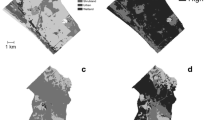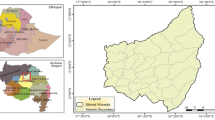Abstract
Nineteen areas in seven of the nine Azorean islands were evaluated for species diversity and rarity based on soil epigean arthropods. Fifteen out of the 19 study areas are managed as Natural Forest Reserves and the remaining four were included due to their importance as indigenous forest cover. Four of the 19 areas are not included in the European Conservation network, NATURA 2000. Two sampling replicates were run per study area, and a total of 191 species were collected; 43 of those species (23%) are endemic to the archipelago and 12 have yet to be described. To produce an unbiased multiple-criteria index (importance value for conservation, IV-C) incorporating diversity and rarity based indices, an iterative partial multiple regression analysis was performed. In addition, an irreplaceability index and the complementarity method (using both optimisation and heuristic methods) were used for priority-reserves analyses. It was concluded that at least one well-managed reserve per island is absolutely necessary to have a good fraction of the endemic arthropods preserved. We found that for presence/absence data the suboptimal complementarity algorithm provides solutions as good as the optimal algorithm. For abundance data, optimal solutions indicate that most reserves are needed if we want that at least 50% of endemic arthropod populations are represented in a minimum set of reserves. Consistently, two of the four areas not included in the NATURA 2000 framework were considered of high priority, indicating that vascular plants and bird species used to determine NATURA 2000 sites are not good surrogates of arthropod diversity in the Azores. The most irreplaceable reserves are those located in older islands, which indicates that geological history plays an important role in explaining faunal diversity of arthropods in the Azores. Based both on the uniqueness of species composition and high species richness, conservation efforts should be focused on the unmanaged Pico Alto region in the archipelago’s oldest island, Santa Maria.
Similar content being viewed by others
References
A.A. Abdel-Monem L.A. Fernandez G.M. Boone (1975) ArticleTitleK–Ar ages from the eastern Azores group (Santa MariaS Miguel and the Formigas Islands) Lithos 8 247–254
J. Adis (1979) ArticleTitleProblems of interpreting arthropod sampling with pitfall traps Zoologischer Anzeiger 202 177–184
R.S. Anderson J.S. Ashe (2000) ArticleTitleLeaf litter inhabiting beetles as surrogates for establishing priorities for conservation of selected tropical montane cloud forests in Honduras, Central America (Coleoptera; StaphylinidaeCurculionidae) Biodiversity and Conservation 9 617–653
L. Andriamampianina C. Kremen D. Vane-Wright D. Lees V. Razafimahatrata (2000) ArticleTitleTaxic richness patterns and conservation evaluation of Madagascan tiger bettles (Coleoptera: Cicindelidae) Journal of Insect Conservation 4 109–128
M.B. Araújo P.H. Williams (2000) ArticleTitleSelecting areas for species persistence using occurrence data Biological Conservation 96 331–345
M.B. Araújo P.H. Williams (2001) ArticleTitleThe bias of complementarity hotspots toward marginal populations Conservation Biology 15 1710–1720
Y. Basset V. Novotny S.E. Miller R. Pyle (2000) ArticleTitleQuantifying biodiversity: experience with parataxonomists and digital photography in Papua New Guinea and Guyana BioScience 50 899–908
D. Borcard P. Legendre P. Drapeau (1992) ArticleTitlePartialling out the spatial component of ecological variation Ecology 73 1045–1055
P.A.V. Borges (1997) Pasture arthropod community structure in Azorean islands of different geological age Imperial College University of London.
P.A.V. Borges (1999) ArticleTitlePlant and arthropod species composition of sown and semi-natural pasture communities of three Azorean islands (S. MariaTerceira and Pico) ArquipélagoLife and Marine Sciences 17A 1–21
P.A.V. Borges C. Aguiar G. André H. Enghoff C. Gaspar C. Melo J.A. Quartau S.P. Ribeiro A.R.M. Serrano L. Vieira A. Vitorino J. Wunderlich (2002) Relação entre o número de espécies e o número de táxones de alto nível para a fauna de artrópodes dos Açores C. Costa S.A. Vanin J.L. Lobo A. Melic (Eds) Hacia un Proyecto CYTED para el Inventario y Estimación dela Diversidad Entomológica en Iberoamérica PrIBES-2001. M3m: Monografias Tercer Milenio SEA Zaragoza 55–68
P.A.V. Borges V.K Brown (1999) ArticleTitleEffect of island geological age on the arthropod species richness of Azorean pastures Biological Journal of the Linnean Society 66 373–410
P.A.V. Borges V.K. Brown (2001) ArticleTitlePhytophagous insects and web-building spiders in relation to pasture vegetation complexity Ecography 24 68–82
P.A.V. Borges V.K. Brown (2003) ArticleTitleStudying arthropods in pastures: the need for complementary use of suction sampling and pitfall trapping methods Graellsia 59 5–22
P.A.V. Borges A.R.M. Serrano J.A. Quartau (2000) ArticleTitleRanking the Azorean Natural Forest Reserves for conservation using their endemic arthropods Journal of Insect Conservation 4 129–147
K.S. Brown SuffixJr. (1997) ArticleTitleDiversity, disturbanceand sustainable use of Neotropical forests: insects as indicators for conservation monitoring Journal of Insect Conservation 1 25–42
G.M. Clarke (2001) ArticleTitleInvertebrate conservation in Australia: pastpresent and future prospects Antenna 25 8–21
N.M. Collins J.A. Thomas (Eds) (1991) The Conservation of Insects and Their Habitats Academic Press New York, London
R.K. Colwell, (1997) EstimateS, Statistical Estimation of Species Richness and Shared Species from Samples. Version 5 User’s Guide & Application Published at http://viceroy.eeb.uconn.edu/ estimates.
R.K. Colwell J.A. Coddington (1995) Estimating terrestrial biodiversity through extrapolation D.L. Hawksworth (Eds) Biodiversity, Measurement and Estimation Chapman & Hall London 101–118
E. Curio (2002) ArticleTitlePrioritisation of Philippine Island avifaunas for conservation: a new combinatorial measure Biological Conservation 106 373–380
J.G.B. Derraik G.P. Closs K.J.M. Dickinson P. Sirvid B.I.P. Barratt B.H. Patrick (2002) ArticleTitleArthropod morphospecies versus taxonomic species: a case study with AraneaeColeopteraand Lepidoptera Conservation Biology 16 1015–1023
E. Dias (1996) Vegetação Natural dos Açores: Ecologia e Sintaxonomia das Florestas Naturais Universidade dos Açores Angra do HeroísmoPortugal
D.P. Faith P.A. Walker (1996) ArticleTitleHow do indicator groups provide information about the relative biodiversity of different sets of areas?: on hotspots, complementarity and pattern-based approaches Biodiversity Letters 3 18–25
G. Feraud I. Kaneoka C.J. Allègre (1980) ArticleTitleK/Ar ages and stress pattern in the Azores: geodynamic implications Earth and Planetary Science Letters 46 275–286
B.J. Fox J.E. Taylor M.D. Fox C. Williams (1997) ArticleTitleVegetation changes across edges of rainforest remnants Biological Conservation 82 1–13
K.J. Gaston (1994) Rarity Chapman & Hall London
K.J. Gaston (1996) What is biodiversity? K.J. Gaston (Eds) Biodiversity. A Biology of Numbers and Difference Blackwell Science OxfordUK 1–9
K.J. Gaston T.R. New M.J. Samways (1993) Perspectives on Insect Conservaton Intercept AndoverUK
M. Graham (2003) ArticleTitleConfronting multicollinearity in ecological multiple regression Ecology 84 2809–2815
R.K. Heikkinen (2002) ArticleTitleComplementarity and other key criteria in the conservation of herb-rich forests in Finland Biodiversity and Conservation 11 1939–1958
P.A. Henderson R.M.H. Seaby (2002) Species Diversity & Richness-Projecto Mamirauá, Version 3.0 Pisces Conservation Ltd.
R.D. Holt (1992) ArticleTitleA neglected facet of island biogeography: the role of internal spatial dynamics in area effects Theoretical Population Biology 41 354–371
P.C. Howard P. Viskanic T.R.B. Davenport F.W. Kigenyi M. Baltzer C.J. Dickinson J.S. Lwanga R.A. Matthews A. Balmford (1998) ArticleTitleComplementarity and the use of indicator groups for reserve selection in Uganda Nature 394 472–475
J.B. Hughes G.C. Daily P.R. Ehrlich (2002) ArticleTitleConservation of tropical forest birds in countryside habitats Ecology Letters 5 121–129
ILOG 2001. C-Plex 7.1.. ILOG, Gentilly, France.
A. Kirchhofer (1997) ArticleTitleThe assessment of fish vulnerability in Switzerland based on distribution data Biological Conservation 80 1–8
D.D. Kohn D.M. Walsh (1994) ArticleTitlePlant species richness – the effect of island size and habitat diversity Journal of Ecology 82 367–377
P. Legendre (1993) ArticleTitleSpatial autocorrelation: trouble or new paradigm? Ecology 74 1659–1673
P. Legendre L. Legendre (1998) Numerical Ecology, Second English edn Elsevier AmsterdamThe Netherlands
J.T. Longino J. Coddington R.K. Colwell (2002) ArticleTitleThe ant fauna of a tropical rain forest: estimating species richness three different ways Ecology 83 689–702
C.R. Margules R.L. Pressey (2000) ArticleTitleSystematic conservation planning Nature 405 243–253
P. McCullagh J.A. Nelder (1989) Generalized Linear Models, 2nd edn Chapman & Hall London
J.L. Moore M. Folkmann A. Balmford T. Brooks N. Burgess C. Rahbek P.H. Williams J. Krarup (2003) ArticleTitleHeuristic and optimal solutions for set-covering problems in conservation biology Ecography 26 595–601
S.G. Nilsson I.N. Nilsson (1976) ArticleTitleValuation of South Swedish wetlands for conservation with the proposal of a new method for valuation of wetlands as breeding habitats for birds Fauna och Flora 71 136–144
J.C.C. Nunes (1999) A actividade vulcânica na ilha do Pico do Plistocénico Superior ao Holocénico: mecanismo eruptivo e Hazard vulcânico Universidade dos Açores Ponta DelgadaPortugal
I. Oliver A.J. Beattie (1996) ArticleTitleInvertebrate morphospecies as surrogates for species: a case study Conservation Biology 10 99–109
W. Powell M.P. Walton M.A. Jervis (1996) Populations and communities M. Jervis N. kidd (Eds) Insect Natural Enemies – Practical Approaches to Their Study and Evaluation Chapman & Hall London 223–292
J.R. Prendergast R.M. Quinn J.H. Lawton (1999) ArticleTitleThe gaps between theory and practice in selecting nature reserves Conservation Biology 13 484–492
A.G. Rebelo W.R. Siegfried (1992) ArticleTitleWhere should nature reserves be located in the Cape Floristic Region, South Africa? Models for the Spatial configuration of a reserve network aimed at maximising the protection of floral diversity Conservation Biology 6 243–252
M.A. Reis O.R. Oliveira L.C. Alves E.M.C. Rita A.F. Rodrigues C.A. Pio P. Fialho M.C. Freitas J.C. Soares (2002) ArticleTitleComparison of continental Portugal and Azores Islands aerosol during a Sahara dust storm Nuclear Instruments Methods in Physics Research Section B (Beam Interactions with Materials and atoms) B 189 IssueID1–4 272–278
R.E. Ricklefs (2004) ArticleTitleA comprehensive framework for global patterns in biodiversity Ecology Letters 7 1–15
A.F. Rodrigues (2001) Aerossóis Atmosféricos com Efeitos no Clima: Níveis e Processos de Transformação no Centro do Atlântico Norte (Região Açores) Universidade dos Açores Angra do HeroísmoPortugal
A.S.L. Rodrigues J.O. Cerdeira K.J. Gaston (2000a) ArticleTitleFlexibility, efficiency, and accountability: adapting reserve selection algorithms to more complex conservation problems Ecography 23 565–574
A.S.L. Rodrigues R.D. Gregory K.J. Gaston (2000b) ArticleTitleRobustness of reserve selection procedures under temporal species turnover Proceedings of the Royal Society of London B 267 49–55
M.L. Rosenzweig (1995) Species Diversity in Space and Time Cambridge University Press CambridgeUK
A.R.M. Serrano (2002) Os coleópteros carabóides endémicos da Península Ibérica em Portugal (Coleoptera: Caraboidea): Padrões de distribuição e tentativa de ordenação das áreas protegidas C. Costa S.A. Vanin J.L. Lobo A. Melic (Eds) Hacia un Proyecto CYTED para el Inventario y Estimación dela Diversidad Entomológica en Iberoamérica : PrIBES-2001. M3m: Monografias Tercer Milenio SEA Zaragoza 277–293
T.R.E. Southwood P.A. Henderson (2000) Ecological Methods, 3rd edn Blackwell Science London
K.D. Sunderland C.J. Topping (1995) Estimating population densities of spiders in cereals S. Toft W. Riedel (Eds) Arthropod Natural Enemies in Arable Land. I. Density, Spatial Heterogeneity and Dispersal. Acta Jutlandica LXX:2 Aarhus University Press Aarhus, Denmark 13–22
W.J. Sutherland (2000) The Conservation Handbook: ResearchManagement and Policy Blackwell Science London
T. Tscharntke I.S. Dewenter A. Kruess C. Thies (2002) ArticleTitleContribution of small habitat fragments to conservation of insect communities of grassland-cropland landscapes Ecological Applications 12 354–363
M.-J. Turquin (1973) ArticleTitleUne biocenose cavernicole originale pour le Bugey: le puits de Rappe. Comptes Rendus 96e Congresse Naturel Sociétès Savantes, Toulouse 1971 Sciences 3 235–256
R.J. Whittaker (1998) Island Biogeography – Ecology, Evolution and Conservation Oxford University Press OxfordUK
R.J. Whittaker K.J. Willis R. Field (2001) ArticleTitleScale and species richness: towards a general, hierarchical theory of species diversity Journal of Biogeography 28 453–470
P. Williams (2001) Complementarity S. Levin (Eds) Encyclopaedia of Biodiversity, Vol. 5 Academic Press New York 813–829
E.O. Wilson (2000) ArticleTitleOn the future of Conservation Biology Conservation Biology 14 1–3
Author information
Authors and Affiliations
Corresponding author
Rights and permissions
About this article
Cite this article
Borges, P., Aguiar, C., Amaral, J. et al. Ranking protected areas in the Azores using standardised sampling of soil epigean arthropods. Biodivers Conserv 14, 2029–2060 (2005). https://doi.org/10.1007/s10531-004-4283-y
Received:
Accepted:
Issue Date:
DOI: https://doi.org/10.1007/s10531-004-4283-y




